The World of Quaker Artists
I once asked a group of Quaker artists whether their art was different from non-Quaker art. “No, it’s not,” one participant responded, and others agreed. This exchange occurred nearly 20 years ago at a Fellowship of Quakers in the Arts (FQA) conference in Burlington, New Jersey. I have contemplated that response in the years since. In that time, I have published over 100 Quaker artists’ works as editor of FQA’s quarterly arts journal Types and Shadows.
In many respects, the “no, we aren’t different” answer is absolutely correct. Like any artist, most Quakers artists appeal to the viewer’s eye for beauty. Our art is about beauty. We want to achieve color, line, texture, light, composition, and provide something that will be restful and long-lasting in someone’s home, business, or institution. We want to evoke feelings of a pleasant memory; a fondly recalled place; or, in the abstract, love and security. Rendering of that beauty varies greatly from artist to artist. Likewise, the mode of beauty desired by the viewers changes dramatically from person to person.
Art by Quakers is enormously varied from Adrian Martinez’s life-size oil portraits (1) to the abstract murals of Zan Lombardo to the mixed media of Asake-Denise Jones (2) honoring women of the Student Non-violent Coordinating Committee (SNCC); from the music of classical guitarist Keith Calmes and poetry of Jen Gittings-Dalton to the life-sized sculptures of Carol Sexton.
Left: 1. Adrian Martinez, Portrait of Humphry Marshall, approx. 5′ x 4′, oil on canvas, one in a series of life-sized paintings displayed at Chester County History Center.
Right: 2. Asake-Denise Jones, Women of SNCC (close-up), 12″ x 13″, mixed media.
Three of my photographs were purchased by Quakers, for varied reasons, no doubt, but all related to beauty. The Allegheny National Forest autumn photograph (3) meant natural scenic depth and color to Charlie Gilbert. He said he was drawn in by the layers in the photograph; for him, as a therapist, the image symbolized the layers of personality. I believe my light painting from a spinning top (4) revealed dimensions of a deep inner life for Grady Lights who purchased it. And Martha Sharples has told me that she gets up every morning to the exuberant face of the Filipina farm woman my family met while walking in her Philippine rice field (5).
Left: 3. Blair Seitz, Autumn, Allegheny National Forest, photograph. Right (top): 4. Blair Seitz, Inside, light painting photograph;
Right (bottom): 5. Blair Seitz, Filipina Rice Farmer, photograph.
Keith Calmes reflects beauty with his classical guitar. One is drawn into the skillfully performed notes of his compositions, played from a heart of peace and love. Diane Faison McKinzie uses First American and African American symbols in her mixed media art (6); her works are beautiful and with clear concerns. Trudy Myrrh Reagan, a California FQA artist, pulls from her family’s deep roots in science. She told me in a Types and Shadows interview:
The lockdown gave me the protected time to undertake this project. . . . The work covers both complementarity (science) . . . and my mysticism vs. doctrines.
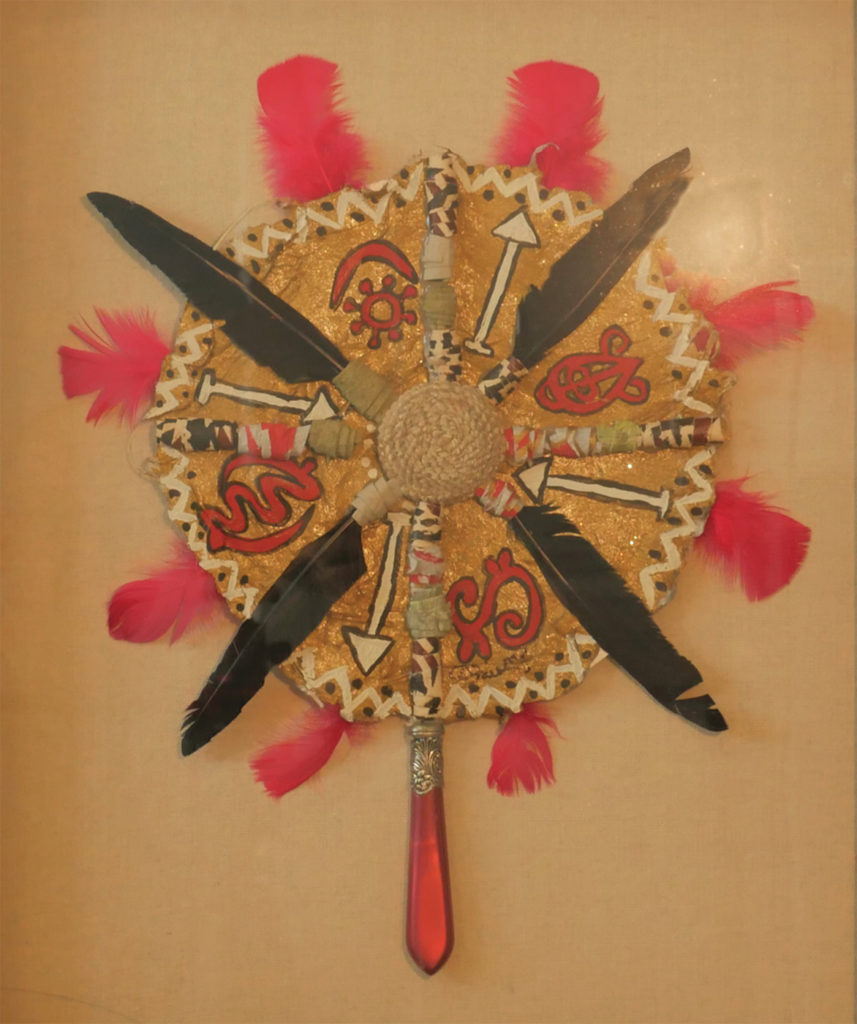
6. Diane Faison McKinzie, Pinwheel, 23″ x 18″, mixed media.
On canvas, Adrian Martinez’s amazingly large projects focus on early Quakers and their relations with Indians. A more recent project on the life of eighteenth-century Friend and botanist Humphry Marshall (1) includes 12 life-sized paintings made in cooperation with the Chester County Historical Society; they took years to complete and are uniquely Quaker.
Most Quaker artists have social or political convictions; some convey their emotion—usually compassion—directly in their art. FQA member Skip Schiel shares photographs of Palestinians who continue to live in refugee camps 74 years after the war of 1948 (7). Judy Ballinger’s 12 years of living in Ethiopia and Sudan frequently emerge, lovingly, as themes in her art (8).
Left: 7. Skip Schiel, photo of Ahmad Ali Hawad at Aida camp for Palestinian refugees, located in the central West Bank.
Right: 8. Judy Ballinger, Bekelech and Pink Parasol, 16″ x 20″, collage, mixed media.
Some Quakers are social activists though they fairly consistently separate their art from advocacy. Collage artist Jonathan Talbot, who also has deep social concerns, keeps this partial separation.
For some, art is a way to heal from abuse. Prolific painter, writer, and FQA board member Jennifer Elam creates her art with her own unique medium mix for her ongoing healing. In her healing workshops, she gives participants the opportunity to use art to heal.
At her exhibit at Pendle Hill study center in Wallingford, Pennsylvania, Bronwen Mayer Henry (9) explained her art and physical healing:
In 2013, I started painting while I was in isolation navigating thyroid cancer treatment. After treatment and experiencing such bliss [while] painting, I decided I didn’t have to have cancer to do such a restorative practice. Now I’m at the canvas daily.
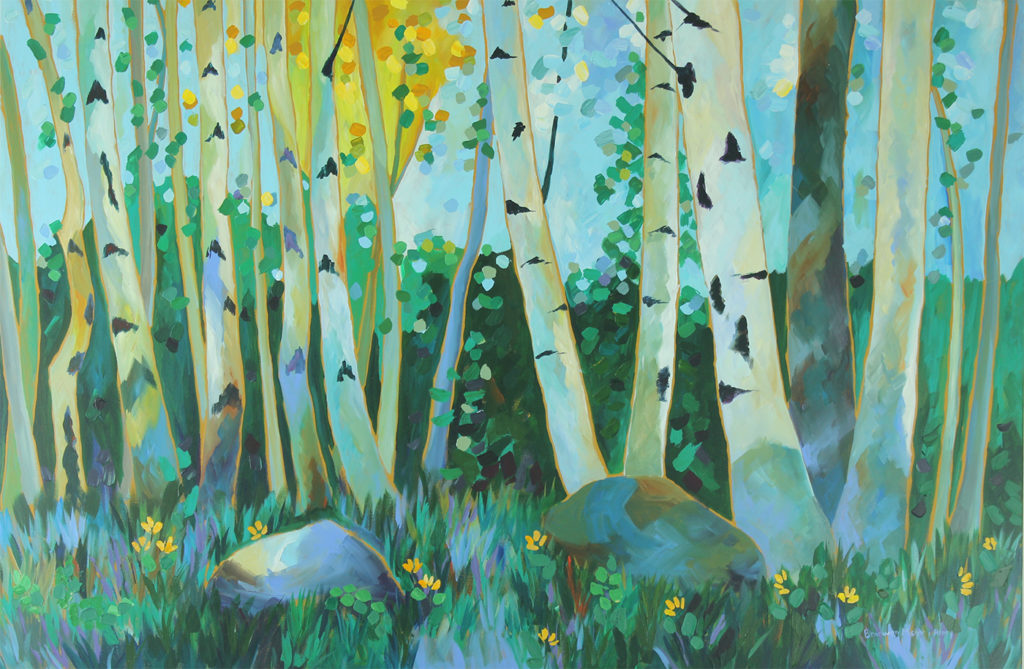
9. Bronwen Mayer Henry, Motion of Love, 40″ x 60″, acrylic on canvas.
Many Quaker artists use words with their art; Bonnie Zimmer and John Holliger, for example, merge poetry with their visuals. Holliger’s leaf photograph (10) is part of his digital booklet The Beauty of Symmetry and Chaos. The first lines of his poem for the leaf photo are “The shape of a leaf / Born out of chaos / Beauty echoing through a forest.”
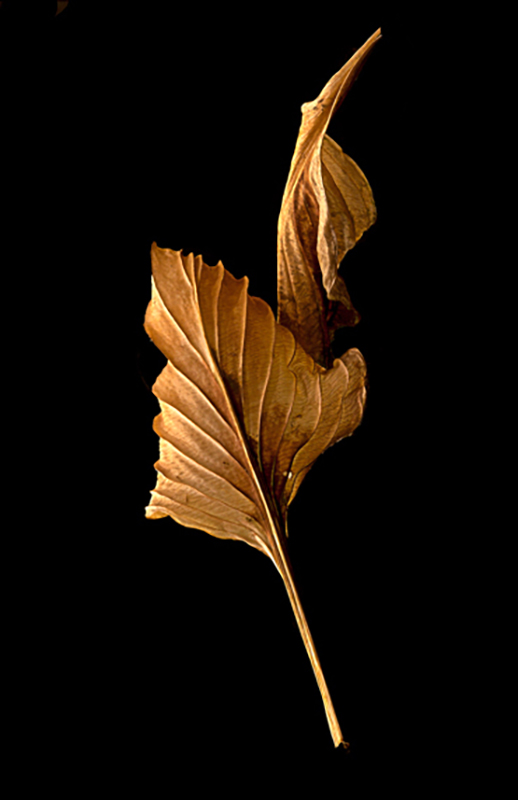
10. John Holliger, photograph of leaf in The Beauty of Symmetry and Chaos digital booklet.
Indeed, Quaker art can claim humor and satire. Pulitzer prize-winning Quaker artist Signe Wilkinson is the editorial cartoonist for the Philadelphia Daily News. Long-term FQA board member Chuck Fager writes creatively on Quaker subjects; his books include Remaking Friends; Murder at Quaker Lake; and a humorous book, Quakers Are Hilarious!.
In the winter 2021-2022 issue of Types and Shadows, Richard Brown Lethem comments on his paintings at his La Verne, California exhibit:
The ongoing focus of my painting is the paradox and the mystery of the body’s inseparable relationship to the Spiritual and how to manifest this . . . in the language of paint.
Quakers also have the nude human figure in their artworks with purpose. Quaker Arla Patch, a Native American activist, projects nature images onto the nude body, perhaps to illustrate consciousness with all of creation. Cai Quick, a recent art scholar at Pendle Hill, shows the nude body melded with a green tree alone in scrubland with storm clouds, perhaps to show transgender health in a difficult landscape.
Over the last half-century, Quaker artists have become partners in exploring more deeply our shared spirituality. Beauty expressed in art has become a path to traveling further into God’s mysteries and creation.
Though not only the province of Quaker artists, art as healing and art as advocacy is a precious spoken or quiet creativity promoting Quaker values, particularly love and peace showing “that of God in all” inclusion. Quaker artists are a varied group creating varied art, a creative community exhibiting deeply rooted emotions, including joy.










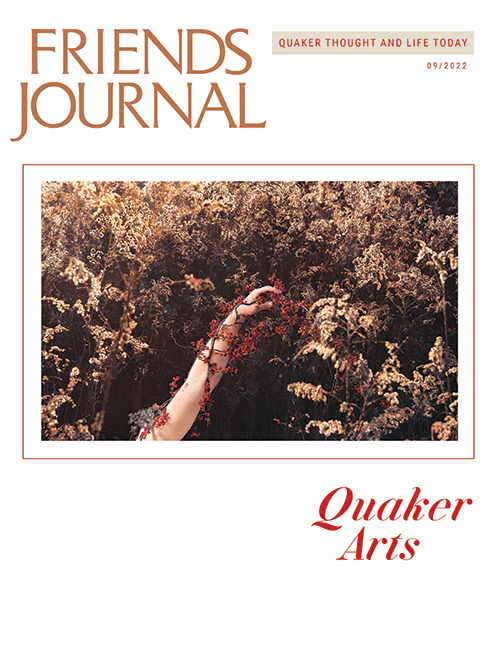
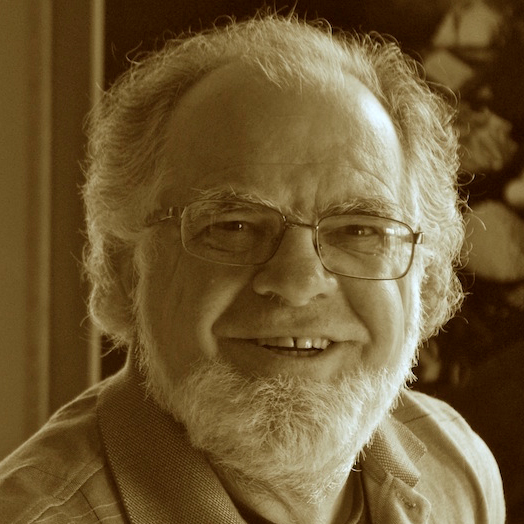
On art:
Can we detach the blistering, intense energy of a Van Gogh painting from his stalking and psychosis? Or Wagner’s music from his megalomania and anti-semitism? Picasso from his misogyny? Plato!’s transcendent awareness from his snobbery? I think the answer may challenge our capacity for forgiveness and vision.
What I feel is different about Quaker art has to do with the person of its creator, and their manifest benevolence.
Good points, Rob. My association with Quaker artists is filled with consideration, love, good will–our FQA board relates with listening, respect and love for one another. Blair Seitz
My name is Rita from BC, Canada and I am a Quaker explorer …although some like to call it an Inquirer. My husband has a strong passion for making folding knives.. and at the beginning of his knife-making thought of it as “Jewelry with an Edge”
As an art-form and in Quaker opinion, I am wondering what Quaker thoughts are around this. Society has created the thought of knives to be evil ..and as an early Quaker explorer myself value any Quaker thoughts about social innuendos and norms. Please reply to my email, wiebe.bc@gmail.com as I (a non-techie) may lose this thread. Warmly, Rita Wiebe in BC, Canada